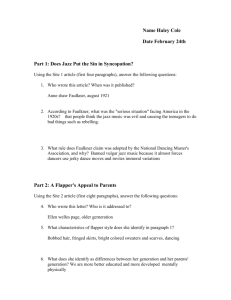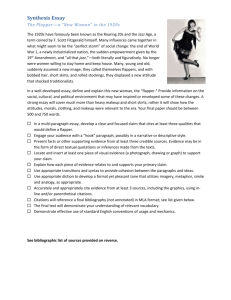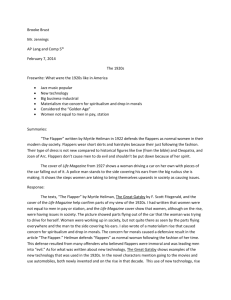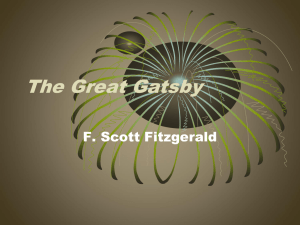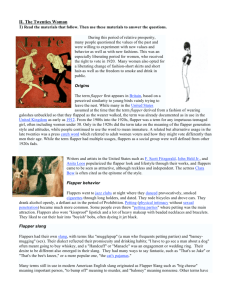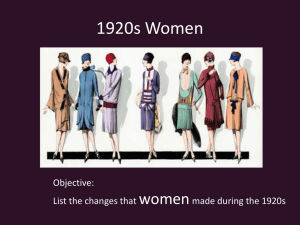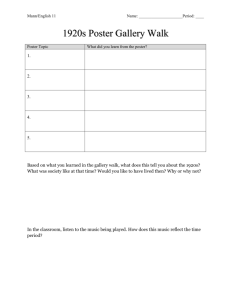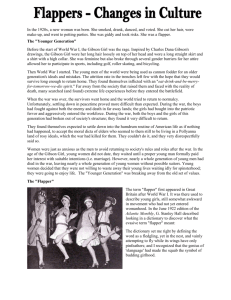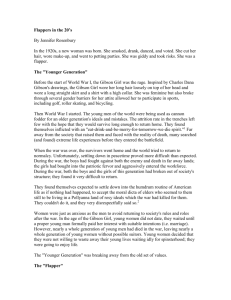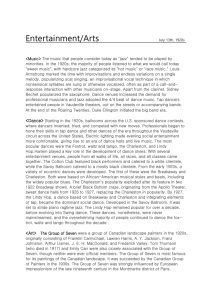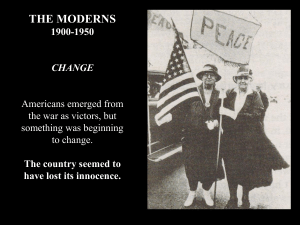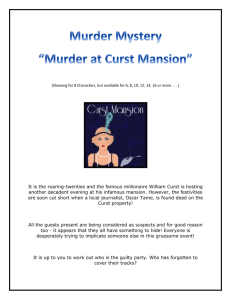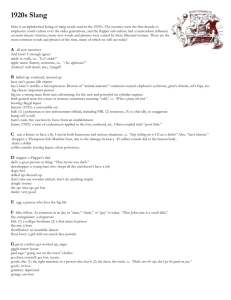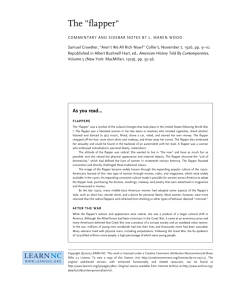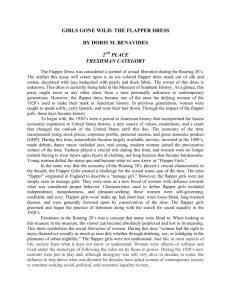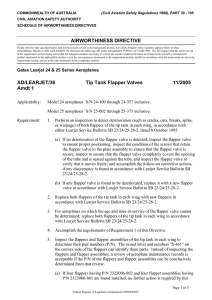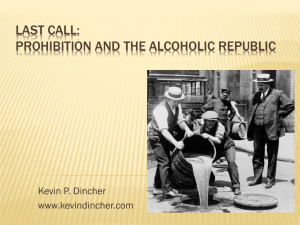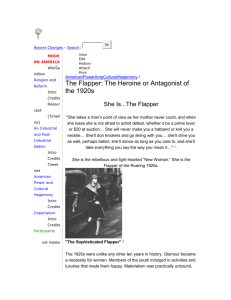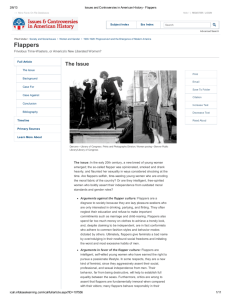Dance with a flapper
advertisement
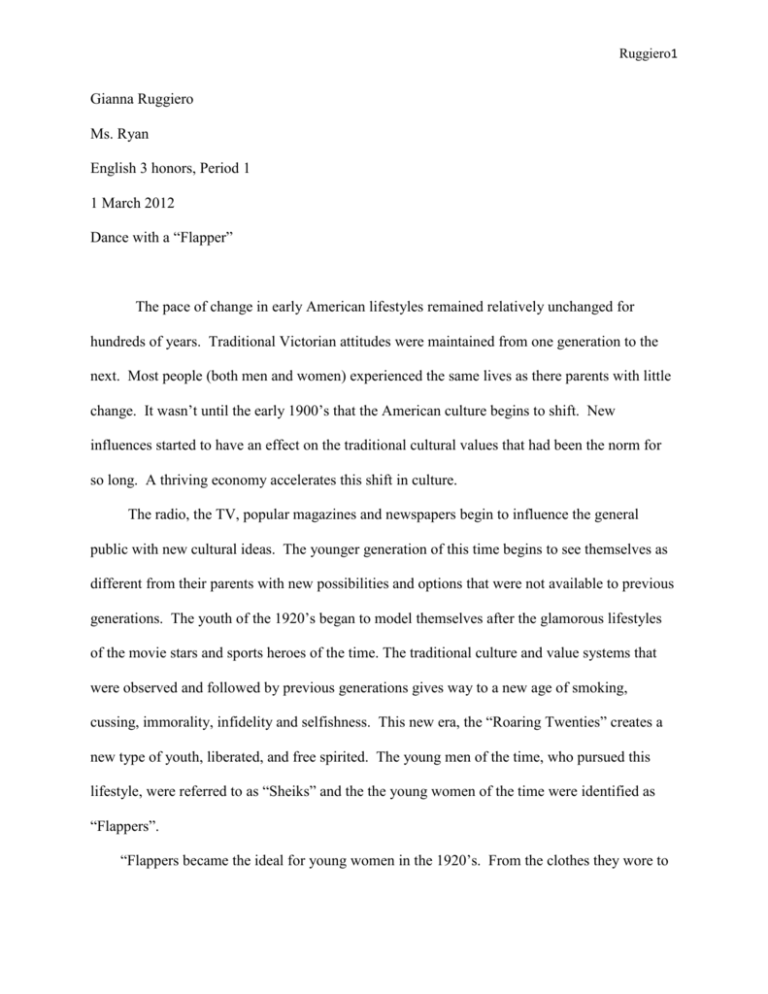
Ruggiero1 Gianna Ruggiero Ms. Ryan English 3 honors, Period 1 1 March 2012 Dance with a “Flapper” The pace of change in early American lifestyles remained relatively unchanged for hundreds of years. Traditional Victorian attitudes were maintained from one generation to the next. Most people (both men and women) experienced the same lives as there parents with little change. It wasn’t until the early 1900’s that the American culture begins to shift. New influences started to have an effect on the traditional cultural values that had been the norm for so long. A thriving economy accelerates this shift in culture. The radio, the TV, popular magazines and newspapers begin to influence the general public with new cultural ideas. The younger generation of this time begins to see themselves as different from their parents with new possibilities and options that were not available to previous generations. The youth of the 1920’s began to model themselves after the glamorous lifestyles of the movie stars and sports heroes of the time. The traditional culture and value systems that were observed and followed by previous generations gives way to a new age of smoking, cussing, immorality, infidelity and selfishness. This new era, the “Roaring Twenties” creates a new type of youth, liberated, and free spirited. The young men of the time, who pursued this lifestyle, were referred to as “Sheiks” and the the young women of the time were identified as “Flappers”. “Flappers became the ideal for young women in the 1920’s. From the clothes they wore to Ruggiero2 their attitudes, flappers were youthful, chic, and above all, modern. Flappers and their happygo-lucky lifestyle set the tone for American popular culture. They partied, drank, smoked cigarettes and danced to wild jazz” (Routledge). The traditional concept of wife and mother were not the pursuits of the flapper. She was more interested in the moment. Having fun far outweighed the concepts of security and family. “She was the embodiment of the youthful exuberance of the jazz age. Although she defied many of society’s taboos, she was also seen by many as the ideal young woman and was described by author F. Scott Fitzgerald as “lovely, expensive and about nineteen”(Sauro). The flapper was known by a very distinctive fashion statement. They wore their hair short and/or shingled about cheek-length. This hair style was known as a “Bob”. The long hair styles of the previous generations are no longer the style. The short sexy sassy look becomes the icon for the era. The stereotypical clothing worn by a flapper would be a short straight loose fitted dress with a low waistline. She wore silk stocking with sexy garters. Her carefree disregard of authority was reflective in her dress and make-up (bright colored lipstick). Evening gowns were bright and flashy (sequins) with plunging neck lines and back lines. She seldom wore underwear which reinforced her liberated appeal. The dresses were often slit along the sides or front to enable her to dance the up beat jazz rhythms of the day. One of the most familiar dances of the time was known as the Charleston. The flapper was a woman rebelling from the traditional cultures and values that had been the mainstream for many generations. Her look and attitude was a reflection of the times. She was liberated and selfish. She was tired of following the traditional standards/rules that woman before her had been shackled with and forced to follow. She was tired of being subservient to a man. The flapper steps out and becomes more independent as she enjoys the freedoms of her Ruggiero3 sexuality. The Great Depression of 1929 quickly puts an end to the era of the Flapper. However, many freedoms and cultural values associated with the modern woman of today have their origins from the freedoms acquired by the Flapper of the early 1900’s. Ruggiero4 Source Citation Routledge, Chris. "Flappers." Bowling, Beatniks, and Bell-Bottoms: Pop Culture of 20thCentury America. Ed. Sara Pendergast and Tom Pendergast. Vol. 2: 1920s-1930s. Detroit: UXL, 2002. 261-263. Gale U.S. History In Context. Web. 29 Feb. 2012. Sauro, Clare. "Flappers." Encyclopedia of Clothing and Fashion. Ed. Valerie Steele. Vol. 2. Detroit: Charles Scribner's Sons, 2005. 88-89. Gale U.S. History In Context. Web. 1 Mar. 2012.
